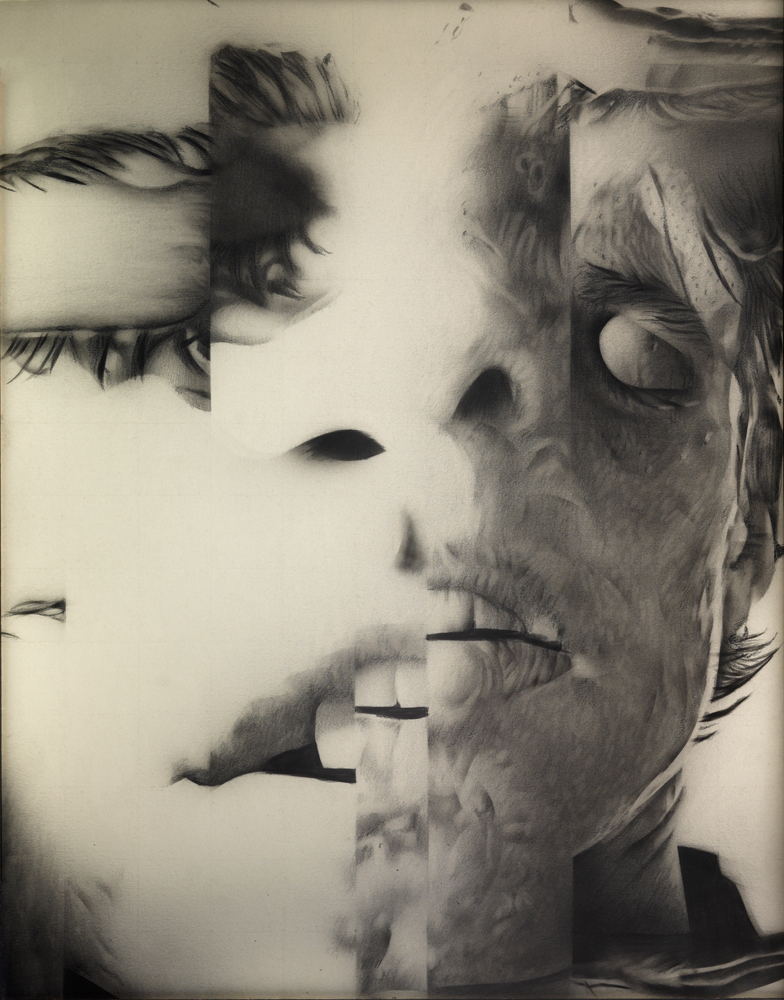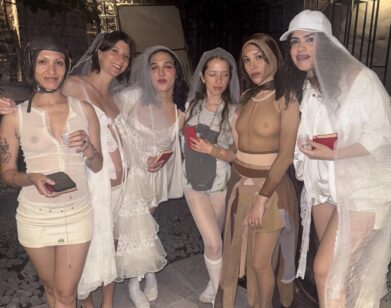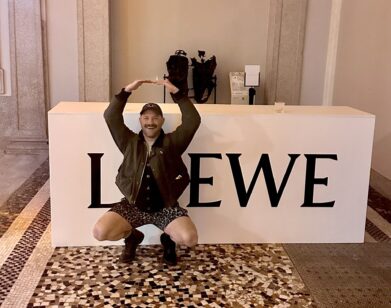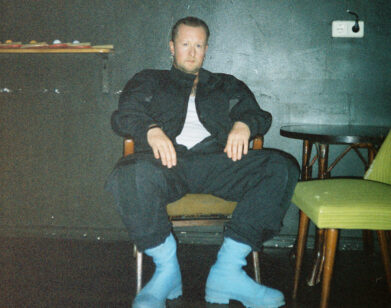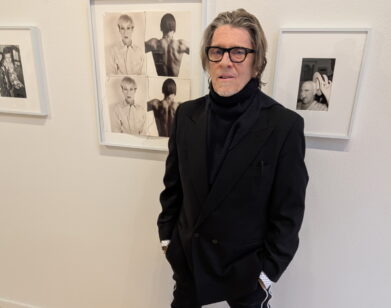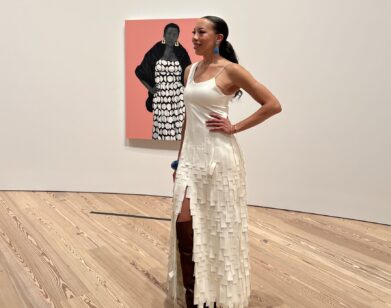The End of Jim Shaw
JIM SHAW IN LOS ANGELES, OCTOBER 2015. PORTRAITS BY CARA ROBBINS.
For more than three decades, Los Angeles-based artist Jim Shaw has explored various mediums, ranging from drawing, painting, sculpture, and installation to staging shows made entirely of found objects—and by objects, we mean paintings purchased at thrift stores. A seminal show, literally titled “Thrift Store Paintings,” was held in New York in 1991, nearly 15 years after the artist received his MFA from CalArts. Now, “Thrift Store Paintings” is restaged on the third floor of The New Museum as part of Shaw’s first-ever New York survey, “Jim Shaw: The End is Here.” Adding to his collection of found canvases is a comprehensive range of comic book drawings, manipulated imagery, and surreal sculptures, most of which come from his projects “Dream Drawings” (1992-99), “Dream Objects” (1994-present), and “My Mirage” (1985-91). Shaw’s all-encompassing installation Labyrinth: I Dreamt I was Taller than Jonathan Borofsky transforms the museum’s fourth floor into a room where one must contemplate sexual desires, gender identity, America’s underbelly, politics, and more—all of which are themes that resonate throughout his expansive body of work.
Simultaneously, Shaw has a show on view at Metro Pictures in New York. Just after the opening of each exhibition, the Michigan-native spoke with painter Peter Saul, whose work also references pop culture, surrealism, and cartoons.
PETER SAUL: I’ll do my best to ask a few questions and hope it’ll encourage you to answer. First, did we first meet at that thrift store show in Switzerland, where you were showing your thrift store paintings?
JIM SHAW: I think the first time we met you were in a show in Los Angeles. Maybe it was the hand-painted pot show.
SAUL: Oh golly, I’d forgotten! My memory of your work starts with the comic strip Archie character in that space capsule. You sent me an announcement for the show. I meant to make contact, but I’m such an isolated person so I never did. I’m sorry about that.
SHAW: It’s okay. I’m getting more and more isolated as I get on in years. I think people’s insanity starts to slowly take over. When you’re younger, you go out and you’re convivial because you have to be. But once you don’t have to meet people anymore, what’s your motivation in going out? It’s partly that getting around L.A. sucks, but I wish I was more outgoing.
SAUL: When you go out, do you visit art shows unlike your own? For instance, traditional brushstroke and color shows?
SHAW: If they’re in a museum that I’m going to or they’re friends of mine, yeah. I only go to shows of friends or people I know because it’s so hard to get anywhere.
SAUL: It’s the same with me. The art shows are usually so restricted.
SHAW: It’s good taste versus not good taste. I realized that I wasn’t naturally born to good taste. I understand what it is, but I am happy to wear bright colors. I do have a few items of black clothing, but I think good taste and doing the same thing over and over again is what the whole art world has become. It’s the easiest thing to organize around. If you have everything as a possibility, it’s a lot harder to understand.
SAUL: Have you ever believed in a religion?
SHAW: When I was a young child, I went to church. When I was hippie, I believed in some hippie ideas. But somewhere, with the aftermath of Woodstock, I lost that… They say the one thing that people who live the longest have in common is that they have a religious belief.
SAUL: It doesn’t apply to me. [laughs]
SHAW: We’re talking about people who live past 100.
SAUL: Okay, I’m not there yet. That’s a long time. Gee witkins… When I first saw the thrift store show pictures, I didn’t believe that you actually found those. I’ve been to thrift stores and didn’t see one picture! All I saw was used clothes. Is that typical?
SHAW: It depends on the thrift store. You used to not find many at the Goodwills, but Saint Vincent de Paul might be chockfull of them. I’ve just been lucky at times. But also, I cheat. I go to flea markets, where other people have gone to the thrift stores. Now, in my work, I feel like I have to avoid certain thrift store-isms, having been known for the thrift store paintings. It’s like I have to not paint that way.
SAUL: That makes sense.
SHAW: It makes a little sense. It makes paranoid, irrational sense. The only kind I’m capable of making, really.
SAUL: I see modern art shows, I pretend to be interested and god—I don’t know what to say. I don’t expect to be interested in art shows. I expect to nod my head and acknowledge talent as its defined. Your show is really the best I’ve seen in an incredibly long time.
SHAW: It’s like there can’t be too many artists given admission to the pantheon who do the kind of stuff we do. All hell would be breaking loose.
SAUL: I think we’re very fortunate to have met the right people, or something like that. If you get to live off your work, you’re very lucky.
SHAW: Absolutely. I’ve had far more success than I ever expected. But I do think that a lot of successful artists have an aim to be successful, even if they don’t outwardly sound like it. I never really expected success.
SAUL: What is success, anyway? Success is someone else’s opinion.
SHAW: Or what you believe someone else said was a success. I ran into a guy at The New Museum who I’d gone to undergrad with…I don’t know what he’s done, but he may well have succeeded better in his family life than I have. There’s a lot of different kinds of success. I’m so dedicated to the making of the art that the rest of my life atrophies, unfortunately.
SAUL: I think I’ve stumbled along as best I can. I’m a person of good will, not trying to do anything negative, and hoping for the best.
SHAW: That’s all you can do, because even if you do your best, things can go awry. Or maybe because you’re trying your best, they go awry. My parents let us fall down or not fall down, and I did okay. I’m still stunned by the way I was treated as a kid, being this wimpy weirdo. It’s affected everything else ever since because I just wasn’t a very masculine boy. I wouldn’t scream and yell at people.
SAUL: That’s okay. I suffered from anti-Semitism. It seems so crazy now. I can’t even describe it. I don’t even want to think about it. For some reason, I don’t really need to have much approval. Do you feel like that about yourself?
SHAW: At this stage of life, yeah. But when I was younger, it stung to be left out of things. If you’re utterly immune to criticism, that’s great. But I’m not.
SAUL: I think I was extremely rebellious when I was young and I’m less rebellious now. The people I feel most sorry for in the art field are the people who followed the rules and then discovered there were 200,000 other people following the same set of rules.
SHAW: If what is doing well at the moment is what you want to do, then it’s okay. But if you have to alter what you’re doing for the sake of that [current trend], you’re gonna get screwed. If you’re an innately tasteful person, who makes innately tasteful art, then good for you.
SAUL: There are two anxieties. One is that you’re afraid you’re going to be left out because you’re not like other people. The other is that you’re afraid you’re going to be overlooked because you weren’t different. My anxiety comes from a fear that I’m not different from other artists. I try, I give it some effort, I think, “What can I do this time, as a picture?”
SHAW: One of the drawbacks of what I do is that I do so many things. I realize when a piece is finished, “Oh geeze, that’s like so-and-so’s work,” that I was subconsciously influenced by someone.
SAUL: I feel isolated. I kind of enjoy isolation. I’m not somebody who craved to be part of a group. If I did crave it, I would’ve contacted you back when we first met. It’s crazy that I didn’t do that. It’s a big mistake.
SHAW: Well, we are different generations.
SAUL: How old are you?
SHAW: 63. I’m only three years away from social security eligibility.
SAUL: I’ve been enjoying that. It smooths out the income.
SHAW: After all these years, I’ve gotten used to a bumpy income. I’ve had problems, like the last crash. I could sense there was going to be a crash, I just didn’t save enough money to get through it.
SAUL: Are you still employing some of your ex-students?
SHAW: Yeah, but not nearly as many. I have to be ready to go down to zero if the ball drops.
SAUL: I’ve never paid to have someone to come into the studio. It makes life less expensive if there’s nobody there with you. My ideal is to find someone to stretch canvases for the next four, five years, because otherwise the doctor calls you a fool when you arrive with some pulled muscle that will never heal. But anways, let’s see here… I don’t believe that these thrift store paintings were all found and you didn’t paint some, but I dare not ask.
SHAW: Go ahead and ask. You can see ones that I had made by assistants at the show at Metro Pictures. Someone could purposefully make something thinking, “I bet Jim Shaw goes to this thrift store,” and plant it there. I might be suckered into buying something if it has a melting eyeball or a sad girl.
SAUL: Sad girls or melting eyeballs—I never saw those things when I was a kid because my father wouldn’t let them in the house.
SHAW: I was allowed to have comic books, but not monster magazines. My father was very focused on newspaper-oriented things, including newspaper comics. Comic books, in a sense, were acceptable, but monster magazines, not so much. This was well after the period of horror comics. [Comics] are all we had—these weird things exuded from the effects of the censorship. I grew up with the comics that came out of that and they were just weird.
SAUL: Like people get theirs heads cut off and there’s no blood?
SHAW: It’s more like nobody could ever get killed. So many things were cut out that nothing much happened in the stories. The stories were all based on science and rational thinking.
SAUL: Terrible! No wonder I paid no attention.
SHAW: We always want to see the bad guy get away with shit, like Tony Soprano. Because we don’t get away with anything.
SAUL: We agree on so much. I really just want to congratulate you on the show…
SHAW: One thing I noticed over time is that if I got a bad review, usually the bad part of it was at the very end. I could tell that nobody read the whole review because they would just say, “It was great to see the review!” In a way, my brain shuts down at the end of an article. It doesn’t really want to go to the end.
SAUL: It seems that you’re liable to get a good review if you’re somebody they might meet. It seems like they keep the worse reviews for people they’re never going to meet, like dead or foreign. They don’t want fine arts to be polluted. It’s too bad.
SHAW: I can understand that, but we’re anomalies I think, which might be for the best.
SAUL: It’s a situation where respectability is the highest virtue. It’s not supposed to be exciting on any level; it’s supposed to be good.
SHAW: There’s so much art and it’s gotten so flashy. In the global marketplace, having art that’s shiny and has neon lights is almost what you need for anyone to notice it in an art fair situation—and art fairs seem to be more and more the only thing there is.
SAUL: I can do nothing but paint 10, 11, or 12 pictures a year. That’s my speed. I’m going to continue with the 19th-century way of life. I’m at peace with it. Whatever happens, I don’t really care.
SHAW: I agree. I just need an income. That’s the only part I care about. The other main focus for me is what’s next? In a way, having a retrospective is easy because I don’t care that much about it. I’m glad it’s happened, but I’ve given up control. I realized having a more subdued banquet is not a bad thing, even though at heart I’m someone who would overstuff any show I could.
SHAW: Do you operate well with deadlines? If I don’t have a deadline, I could fuss around with stuff for forever.
SAUL: Yes. I have a deadline right now. I have to finish my painting by the end of the month. It’s been a while since I haven’t had a deadline. I’m definitely a deadline artist.
SHAW: The one thing I’m jealous of a signature-artist situation is that if you just do one thing and slight variations on it, you wouldn’t have to kill yourself to get a show done. I’m sick of killing myself.
SAUL: I feel under a certain obligation to speak of art and relate to your work, but mostly, I just talk about myself. Do you do that too?
SHAW: It’s the only thing I know well in popular culture aspects. I’m sitting there talking about [one of my] paintings based on a very important French patriotic painting and I can’t remember the name of the artist who painted it. That happens over and over again.
SAUL: You don’t mean Delacroix, do you? That painting where Liberty is posing?
SHAW: Yeah, that’s the one, the Delacroix [Liberty Leading the People]. I was thinking, “Oh, I could separate these into two separate paintings and make one of them into a bodice-ripper cover and the other into a violent, necrotic war scene.”
SAUL: My most embarrassing experience is I was talking about my art to a group of 50-60 people and someone suddenly said, “Can you name five living artists that you like?” I couldn’t think of anyone. No name occurred to me in my head. I was just thinking about myself. So she said, “That’s what I thought,” and I really felt lousy. So then I made a list of artists that I liked, including you as a matter of fact. I put it in my wallet and kept it there for seven or eight or 10 years. No one ever asked again.
SHAW: I can never remember names. I’m so self-centered and have a terrible memory… There’s so many bigger things in the world. The art world is such a tiny little thing compared to wars and migration crises. It’s weird to be self-absorbed in it. But I guess if we were refrigerator salesmen, we’d be self-absorbed with the ins and outs of refrigerator sales.
SAUL: What I have in the back of my mind [is] will Interview be able to get what they need? I went through the trouble of looking up Interview magazine on the computer, which I don’t even use the computer really. I read a typical interview and I thought, “My god! I guess I can do this.”
SHAW: I remember the Andy Warhol interviews, attempting to be as blank as possible.
SAUL: Somebody’s got to fill the air. Warhol got on well with older women, ex-movie stars, didn’t he? Women in their late 80s.
SHAW: Mother figures. [both laugh]
SAUL: I only met the guy once or twice and he did not seem very friendly, so I never pursued it.
SHAW: I read a book called Madness and Modernism. It was going over the diagnosis of schizoid, which I determined I must have because that’s what you typically do—you think you suffer from whatever you’re currently studying. But Warhol was a prime example of a schizoid person. Most of them were writers. Maybe he had Asperger’s, or maybe he was just an amorous human being on earth.
SAUL: Asperger’s is more like it.
SHAW: Asperger’s isn’t too far from schizoid. I feel like schizoid is a precursor to schizophrenia or manic depression. I feel like I’m manic. I have parts of schizoid, parts of Asperger’s. I’m a smorgasbord of neuroses.
SAUL: After the neuroses ends eventually it becomes something you can use in your art. I think I’m getting more mentally healthy, but it’s kind of late in game…I have epilepsy. Does that count as anything?
SHAW: I was reading Hallucinations and I didn’t realize epileptics have all kinds of hallucinations.
SAUL: I felt honored to have the Van Gogh disease. All you do is take one pill in the morning and one in the evening and it knocks it out, unless it’s something worse. But nothing’s happened. Let’s not talk about that. I try to ignore any serious stuff. I’m just trying to have calm painting days, 19th-century style, all by myself with Sally in the house. We live in Germantown, north of New York. We keep the apartment, but don’t keep a studio in the city anymore. It’s too much struggle.
SHAW: I’m jealous of that time when you could afford lofts and survive on almost nothing. You can’t do that anymore. I tried to go to Cooper Union in 1970, but my parents didn’t do much research and I did not realize there was no dorm, that I’d have to find an apartment. I was completely unprepared for that aspect.
SAUL: I think I was always looking for a little bit of luxury and New York didn’t have anything like that in 1970.
SHAW: It had all that grit. I was listening to The Velvet Underground. It sounded romantic, until I was faced with the reality of it. We didn’t realize it at the time, but we were going through the worst economic period past the Great Depression, circa 1973. Between the time I entered college and the time I exited, I realized all those teaching jobs that artists were getting were all taken and nobody was selling any art in galleries. So I thought, “Big deal. Who cares. I’m just going to do what I want.”
SAUL: The well-known art world of the 1950s that everybody knows—Jackson Pollock, de Kooning—was kind of unknown when I went to art school in ’51. When I looked at that Life magazine article with Jackson Pollock in it dripping paint, it never occurred to me to read the words. I looked at the photo of the guy dripping paint and I thought, “What a gimmick. That’s gonna last 10 minutes.” I didn’t pay the slightest attention. Then, when I finally realized there was an art world, did I feel comforted? I don’t know.
SHAW: Now it’s a much more ensconced art world. And is it comforting? No, it’s not. More people make a living by making art than ever before, but it’s still not comforting.
SAUL: It’s amazing that something so unneeded as art can get you by.
SHAW: It’s an investment option for a diversified portfolio, the way I see it.
SAUL: I think it’s a crazy option. I would never invest in art.
“JIM SHAW: THE END IS HERE” WILL BE ON VIEW AT THE NEW MUSEUM THROUGH JANUARY 10, 2016.

